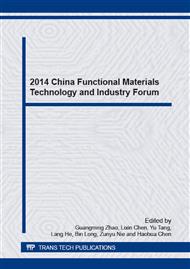p.3
p.9
p.17
p.26
p.31
p.39
p.43
p.53
Synthesis of PbS Nanocrystals by Heterogeneous Reaction
Abstract:
PbS nanocrystals was synthesized by a heterogeneous reaction of hydrogen sulfide gas and lead nitrate solution containing EDTA in ethanol. The influenceof initial molar concentration ratio of EDTA/Pb (NO3)2 (CEDTA/CPb (NO3)2), volume ratio of ethanol/water (Vethanol/VH2O), pH value and flux of H2S on the particle size of PbS were investigated. The structure, morphology, particle size, and particle size distribution ranges of PbS were characterized by XRD, FE-SEM, and laser particle size analyzer, respectively. Increasing CEDTA/CPb (NO3)2, Vethanol/VH2O, and pH value, as well as decreasing the flux of H2S decrease the particle size of PbS. PbS nanocrystals have an average particle size of 69 nm, a narrow size distribution, and a quasi-spherical shape when CEDTA/CPb (NO3)2 is 1, Vethanol/VH2O is 1, pH is 3.5, and the flux of H2S is 20 ml/min.
Info:
Periodical:
Pages:
26-30
Citation:
Online since:
December 2014
Authors:
Price:
Сopyright:
© 2015 Trans Tech Publications Ltd. All Rights Reserved
Share:
Citation:


